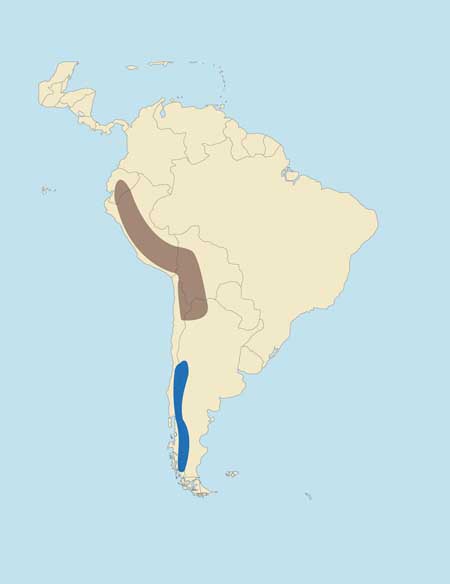 |
 |
Hippocamelus antisensis
Taruca (Sp), Peruanischer Huemul, Andenhirsch (G), Guemal (F). Also called northern huemul, north Andean huemul, or Andean deer. The specific name is for Antisana, an Andean volcano (elevation 18,717 feet or 5,705 m) in the area where this animal is found.
DESCRIPTION (male) Shoulder height 32-34 inches (81-86 cm). Weight 100-120 pounds (45-55 kg).
A robust deer with relatively short legs and long, narrow ears. The coat is coarse and brittle and of a pale, speckled yellowish-gray-brown coloration. Throat, belly, lower legs, inside of upper legs, and rump are white. Tail is brown on top and white underneath. There is a dark V-shaped mark on the forehead, but it does not extend down the face to form a "Y" as in the Chilean huemul. There are white hairs around the muzzle. Antlers are simple forks (two points to a side) branching immediately above the burr, with the front tines often nearly as long as the main beams. Occasionally the tips of the main beams will fork, forming three points to the side, but this is abnormal.
The taruca is smaller and paler than its relative, the Chilean huemul. It also differs by having a lighter rump patch, white rather than black hairs around the muzzle, and longer antlers (especially the front tines) that fork at the burr instead of above it.
BEHAVIOR Lives in small groups of up to eight, including males, females and young, that seemingly are led by females. The mating season is June-August, with fawns (normally one, occasionally two) dropped in February-March. An individual lived more than 10 years in captivity.
Reported to be nocturnal by some observers and active all day by others. Feeds on grasses and sedges. During the rainy season it moves to the highest Andean pastures, moving downward again in the dry season, although seldom below 13,000 feet (3,900 m).
HABITAT High-altitude grassland, scrub and forest, from 13,000-16,500 feet (3,900-5,000 m).
DISTRIBUTION The Andes Mountains of Ecuador, Peru, western Bolivia, northeastern Chile, and northwestern Argentina. Separated by a wide gap from its relative, the Chilean huemul.
STATUS Total population unknown, but believed to be declining from poaching and loss of habitat to farmland at lower elevations, and from competition with domestic stock at higher elevations. Chief natural enemy is the puma, which preys on it heavily. Considered rare except in Peru, where it is locally numerous. Listed as endangered by the USF&WS (1976) and on Appendix I of CITES (1975).
|





